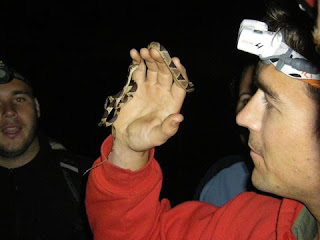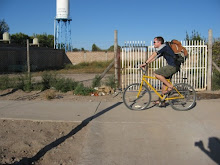 I recently had an opportunity for a break from the routine of Base Camp life when the canopy access guides offered to take me up into the trees. Of all the courses offered here (DNA sampling, habitat surveying, and my mediocre GPS/GIS course), canopy access is hands-down the most exciting option.
I recently had an opportunity for a break from the routine of Base Camp life when the canopy access guides offered to take me up into the trees. Of all the courses offered here (DNA sampling, habitat surveying, and my mediocre GPS/GIS course), canopy access is hands-down the most exciting option. My guide, an Australian guy named Cameron, and I headed out in the morning to the climbing site not far from Base Camp. Cameron is about as chill as they come, and has loads of rock climbing and travel stories. It always makes my travels seem like small beans, and pushes me to travel more, when I hear people's accounts of amazing places like Turkey and Malaysia.
As soon as we got to the tree, a pine rising over 100 feet, Cameron started in on the basics of safety and helped me into my climbing equipment. The gear and concepts behind it were relatively straightforward, but putting them into practice took some work. For example, one piece of equipment called the hand ascender is a device with only two or three moving parts, but the fact that it is connected to a loop into which my foot was placed presented a challenge as I constantly forgot that the two were attached. This made for an initially slow ascent since I would try to move the hand ascender upwards with my weight still on the loop. I can see that those four years of college are really paying off...

When I finally got my shit together, Cameron had me practice a change-over from ascending to descending gear just a few feet off the ground. I again had some difficulty with the basic operations of the gear, but eventually got comfortable enough to head back to the ground to get ready for the real thing. I took the opportunity to re-adjust my harness, which was getting a bit uncomfortable. The slight discomfort, however, didn't compare to that of the harness I wore skydiving a couple of years ago. That, and the fact that I was then fastened to another man and sitting on his lap at 10,000 feet above sea level, made the tree climbing harness seem downright pleasant.
After I got things situated well enough, we started the ascent. Despite spinning around awkwardly once I got off the ground, I eventualy managed a decent rhythm of alternating the processes of standing on the foot loop, pulling the slack of the main rope through the chest ascender, moving the hand ascender up, pulling the safety device up, and repeating. Before I knew it I was a good fifty feet above the ground. The only fear I had during the experience occurred near this height and lasted just a few seconds, after which I decided that, having several points of attachment and a safety line, I was quite safe.
Up, up, up we went. I started thinking about the book I am currently reading, "The Wild Trees", by Richard Preston. It is a rather choppy piece of non-fiction, but provides a good immersion into what the author claims to be one of the last unexplored frontiers on Earth, the forest canopy. The focus is mainly on the arboreal monstrosities of the American northwest, namely redwoods and douglas firs, the upper realms of which have been penetrated by humans only within the last few decades. In the process, entire ecological systems have been documented, including many interesting species of algae and fungi. It is quite a treat to read about such a specific subject and to experience it in the same day.
Once we reached the top of the tree, or the top of the rope at least (the tree had another ten or so feet to offer), I looked around from my perch high above the forest floor and could see why Preston found the canopy a topic worthy of pursuit. Aside from a nice view and a different perspective of the forest itself, the treetop offered a certain sense of peace as well. Cameron commented that the breeze had picked up a bit, making the tree sway slightly. I inquired whether or not that was a good thing, but my Aussie amigo assured me that it was, and that he had actually fallen asleep in the tree the other day.
Sure enough, the breeze was nice. From reading the book and talking to other people who have been high up in trees, I have heard multiple comments that feelings of peace and safety are not uncommon in the canopy. One possible suggestion for this is offered in "The Wild Trees", which points out that ancestors of homo sapiens were mostly, if not exclusively, tree-dwellers, but eventually left for the ground and learned to walk upright. So, the book continues, perhaps the feeling of safety is instigated by a latent evolutionary impulse that is still faintly reminiscent today.
Evolutionary considerations aside, I eventually had my fill of the treetop and its 360-degree view, and told Cameron I was ready to head down. Already in my descending gear, I climbed off the branch I was sitting on and started my descent, a process far simpler, not to mention more fun, than its opposite. On the way down, once we got past the branches, Cameron suggested I try getting away from the tree a bit more. He was right, i was pretty much stuck to the tree, so I tried pushing off the trunk with my feet and, wow, why didn't I do this on the way up? What a blast! I found that, if I gave it enough force, I could jump horizontally off the tree, grab a nearby trunk of another about 10 feet away, hold it for a few seconds, then let go and swing back to the main tree. Awesome!

The second of Cameron's brilliant suggestions was to try hanging upside-down. I was slightly reluctant for a few seconds, but not enough to keep me from doing it. So, with Cameron's help on the first attempt, I followed his instructions and was soon completely upside down. I let go of my equipment, and my inhibitions, and felt the blood sink to my head as I looked at the forest floor fifty feet below. Hanging this way eventually became uncomfortable, so I flipped myself back up and felt a subtle euphoria as my blood returned to its normal locations. I was able to repeat the process once on my own, and once again, awesome!
After another flip and more jumping off the trunk, I descended down the remainder of rope and removed my gear. The whole ordeal only lasted maybe an hour or so, but it was possibly the most enjoyable hour I've had all summer. I am quite grateful for the experience, which may indeed have been of the once-in-a-lifetime variety, and I strongly recommend tree climbing to anyone who has the chance!













